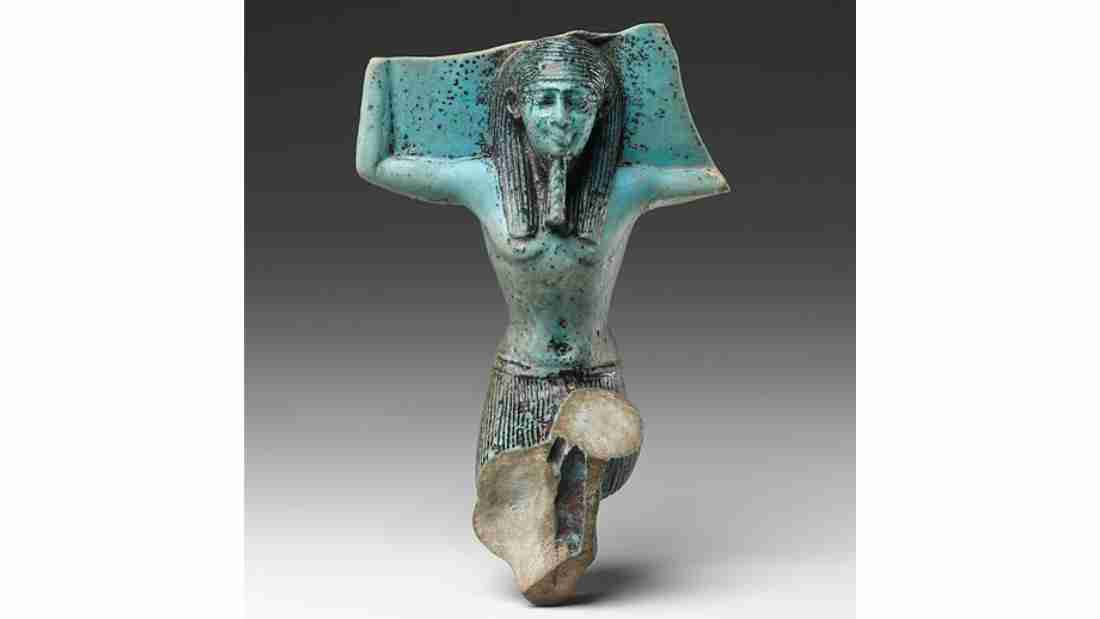The Ancient Egyptian god Shu, often depicted as a man with a feather on his head, was the father of the deities Geb, the earth god, and Nut, the sky goddess. He was revered as the progenitor of the fundamental elements that sustain life and govern the universe, giving him a pivotal position in the divine hierarchy.
The Egyptian God Shu – Separating Earth and Sky
Ancient Egyptian mythology recounts that prior to Shu’s intervention, the earth (Geb) and the sky (Nut) were locked in a tight embrace, creating a claustrophobic and stifling environment.
It thus became Shu’s divine duty to separate his children, lifting Nut high above Geb and establishing the boundaries between the terrestrial realm and the heavens.
The imagery of Shu lifting Nut symbolizes the introduction of order and space into the cosmos, enabling life to flourish in the newly created airy expanse. This act of separation also reflects the Egyptian concept of ma’at, the cosmic order and balance that underpinned their entire worldview.
Shu’s role in maintaining this divine order made him a symbol of stability and harmony.

Shu – The Egyptian God of Peace
Beyond his role in separating the earth and the sky, Shu is also associated with sunlight, clarity, and purity. His representation as a man with a feather on his head symbolizes his connection to lightness and airiness, reflecting his essential nature as a deity of the atmosphere.
Shu’s influence also extended to the realm of protection, where he was believed to shield the world from chaos and disorder, ensuring the smooth functioning of the natural order. This aspect of his character as a guardian deity was of enduring relevance in maintaining balance and stability within the Egyptian cosmology.
Worship and Reverence of Shu
While Shu may not have had as extensive a cult following as some of the more prominent Egyptian deities, his influence permeated throughout the religious and cultural practices of ancient Egypt.
He was often invoked in funerary texts, believed to provide the breath of life to the deceased as they journeyed into the afterlife.
Additionally, his association with air and wind made him a protective deity, guarding against chaotic forces and ensuring the smooth functioning of the natural world.
Posts About the Egyptian Pantheon of Gods
The Pantheon of Ancient Egyptian Gods – A Comprehensive Guide
The Wrath of Montu – The Mythology of the Egyptian War God
Egyptian God Ammit – The Eater of Hearts in Ancient Egyptian Mythology
The Nightly Journey of Khonsu – The Ancient Egyptian God of the Moon
Ihy – The Joyful Ancient Egyptian God of Music
Min – The Ancient Egyptian God of Fertility
The Egyptian God Anubis – His Evolution from Son of Ra to Protector of the Dead
Unraveling the Mysteries of Babi – The Ancient Egyptian Baboon God
Ra, the Egyptian Sun God – Symbolism and Significance in Ancient Egyptian Culture
Sobek: The Ferocious Crocodile God of Ancient Egypt
The Enigmatic Mythology of Horus, the Egyptian Sky God
The Egyptian God Set – Protector of the Desert and Lord of Conflict
The Ancient Egyptian God Medjed: The Guardian of Osiris and the Afterlife
Anput, the Wife and Female Version of Anubis
Selket – The Scorpion Crowned Egyptian Goddess
Shu – The Egyptian God of Air, Wind, Peace and Lions
Hapi the Androgynous Ancient Egyptian God of the Nile
The Egyptian Sky Goddess Nut: Myth and Symbolism
The 42 Laws of Maat: The Moral Principles of the Ancient Egyptians
The Ancient Egyptian Goddess Mut: The Maternal Power in Egyptian Mythology
The Warrior Goddess: Neith in Ancient Egyptian Mythology
The God Bes: The Joyful Dwarf Deity in Ancient Egyptian Culture
The Egyptian Gods of Love: Hathor and Isis in Ancient Egyptian Mythology
Confronting the Serpent: The God Apep, the Nemesis of Ra in Egyptian Myth

